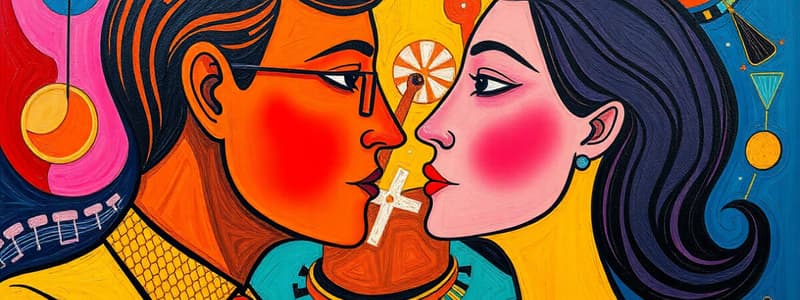Podcast
Questions and Answers
What are the two main types of rewards to which we are attracted?
What are the two main types of rewards to which we are attracted?
Direct and indirect rewards.
Briefly explain the concept of instrumentality in the context of attraction, as described by Eli Finkel and Paul Eastwick.
Briefly explain the concept of instrumentality in the context of attraction, as described by Eli Finkel and Paul Eastwick.
Instrumentality refers to the extent to which someone can help us achieve our current goals; we are attracted to those who help us get what we want.
How does proximity influence relationships, and why is it important?
How does proximity influence relationships, and why is it important?
Proximity makes relationships more rewarding because people are physically and psychologically close, and a few feet can make a big difference.
Define the mere exposure effect and explain how it affects our liking for others.
Define the mere exposure effect and explain how it affects our liking for others.
What are some benefits that good-looking people receive, according to the text?
What are some benefits that good-looking people receive, according to the text?
Describe the 'baby-faced' features in women that are considered attractive, according to the text.
Describe the 'baby-faced' features in women that are considered attractive, according to the text.
What waist-to-hip ratio (WHR) is generally considered most attractive in women, and what does this signify?
What waist-to-hip ratio (WHR) is generally considered most attractive in women, and what does this signify?
Explain the concept of 'matching' in physical attractiveness within established romantic relationships.
Explain the concept of 'matching' in physical attractiveness within established romantic relationships.
How does the Matching Principle influence our relationships?
How does the Matching Principle influence our relationships?
Explain the concept of reciprocity in the context of attraction.
Explain the concept of reciprocity in the context of attraction.
How does being selective affect one's appeal as a potential partner?
How does being selective affect one's appeal as a potential partner?
Cite three specific types of similarities that can lead to attraction and liking between individuals.
Cite three specific types of similarities that can lead to attraction and liking between individuals.
Explain why the saying "opposites attract" is not entirely accurate, according to the information in the text.
Explain why the saying "opposites attract" is not entirely accurate, according to the information in the text.
Describe the Stimulus-Value-Role (SVR) Theory and its three stages of relationship development.
Describe the Stimulus-Value-Role (SVR) Theory and its three stages of relationship development.
What are the three criteria with which people evaluate potential mates, according to the text?
What are the three criteria with which people evaluate potential mates, according to the text?
What is instrumentality?
What is instrumentality?
What are some benefits of symmetrical faces?
What are some benefits of symmetrical faces?
What is mate value?
What is mate value?
Define perceived similarity.
Define perceived similarity.
What are three distinct stages of the SVR theory?
What are three distinct stages of the SVR theory?
Flashcards
Direct Rewards
Direct Rewards
Pleasures people provide, like attention, acceptance, money, and good advice.
Indirect Rewards
Indirect Rewards
Kindness, good looks, and pleasant personalities that attract us unconsciously.
Instrumentality in attraction
Instrumentality in attraction
Extent someone helps us achieve our goals; attracts us to those who fulfill our needs.
Proximity
Proximity
Signup and view all the flashcards
Mere Exposure Effect
Mere Exposure Effect
Signup and view all the flashcards
"What is beautiful, is good" Bias
"What is beautiful, is good" Bias
Signup and view all the flashcards
Matching Principle
Matching Principle
Signup and view all the flashcards
Reciprocity in Relationships
Reciprocity in Relationships
Signup and view all the flashcards
Mate Value
Mate Value
Signup and view all the flashcards
"Birds of a feather, flock together"
"Birds of a feather, flock together"
Signup and view all the flashcards
Perceived Similarity
Perceived Similarity
Signup and view all the flashcards
Stimulus-Value-Role (SVR) Theory
Stimulus-Value-Role (SVR) Theory
Signup and view all the flashcards
Warmth and Loyalty
Warmth and Loyalty
Signup and view all the flashcards
Attractiveness and vitality
Attractiveness and vitality
Signup and view all the flashcards
Status and Resources
Status and Resources
Signup and view all the flashcards
Study Notes
The Fundamental Basis of Attraction
- Attraction is influenced by the rewarding presence of others.
- Direct rewards are the evident pleasures people provide, for example, interest, approval, money, or good advice, and the more direct rewards, the greater the attraction.
- Indirect rewards include kindness, good looks, and pleasant personalities, which can attract without conscious awareness.
- Instrumentality is the extent to which someone helps achieve current goals.
- Attraction is higher towards those whose company is consistently rewarding and fulfills desires, contributing to a sense of belonging.
Proximity
- Relationships are more rewarding when people are physically and psychologically close.
- Physical proximity has a connection with interpersonal attraction.
Familiarity: Repeated Contact
- Repeated contact or mere exposure increases liking.
- Liking increases for people whose faces are recognizable, even without interaction.
- The mere exposure effect describes the preference for things due to repeated exposure, even without conscious awareness.
- Familiarity has limits since gaining negative information can decrease liking with further exposure.
Physical Attractiveness: Linking Those who are Lovely
- Physical appearance is the first noticeable attribute, with a tendency to assume that good-looking people are more likable.
"What is beautiful, is good"
- The assumption is that attractive people have desirable traits like agreeableness and conscientiousness.
- Positive judgments are made automatically upon seeing an attractive face.
- Attractive people tend to earn more money and get promoted more often.
- Attractive professors receive better teaching evaluations, and their classes have higher attendance.
- Attractive politicians are often judged as more competent.
- Attractive people tend to make better impressions in court and receive lower fines.
- Babies spend more time looking at attractive faces.
Who is Pretty?
- Women are considered more attractive with "baby-faced" features, such as large eyes, a small nose and chin, and full lips, which create a feminine and youthful appearance.
- Beautiful women combine baby-faced features with signs of maturity, like cheekbones, a narrow cheeks, broad smile, and long eyelashes.
- Men with strong jaws and broad foreheads are generally considered handsome.
- Slightly feminine, baby-faced features can also make men attractive.
- Symmetrical faces are a sign of attractiveness.
- Men tend to prefer women with a waist-to-hip ratio (WHR) of 0.7, indicating a waist that is 30% smaller than the hips, resembling an hourglass shape.
- Men with broad shoulders and muscles are considered more attractive, with a WHR of 0.9.
- For men, broad shoulders are considered attractive as well, and these men reportedly have more sex partners.
- Men are considered less attractive to women if they are handsome but poor.
- Scent and education also matter in assessing attractiveness.
- Women may prefer men with high facial width-to-height ratio (FWHR) for short-term relationships.
- Facial preferences in women are influenced by their progesterone levels and relationship status, as single women may prefer rugged features, while partnered women show lower preferences for masculine features.
Matching in Physical Attractiveness
- Partners in established relationships tend to have similar levels of physical attractiveness, known as matching.
- Individuals are likely to end up with partners who are about as attractive as they are.
Reciprocity
- Refers to the tendency to like and feel positively towards those who show liking or appreciation.
- Positive feelings create a cycle of mutual positive reinforcement.
- Connections are more likely to form with people who treat you well or express liking for you.
- The most appealing partner is moderately attractive and likely to accept you.
- A partner’s desirability is found by multiplying his physical attractiveness by his probability of accepting you.
- Mate value is the overall attractiveness of an individual as a potential partner for reproduction and long-term partnership.
- The best acceptance comes from potential partners who are selective and don't offer acceptance to everyone
Similarity: Liking People who are Like Us
- "Birds of a feather, flock together" means people with similar interests and values tend to associate.
- Individuals are drawn to others who are like them in personality, lifestyle, beliefs, or behaviors.
- Demographic similarities include age, sex, race, education, religion, and social class.
- The more similar people are, the more they like each other.
- Key personality traits include being agreeable, conscientious, emotionally stable, and easy to live with (OCEAN).
Do Opposites Attract?
- Liking increases with commonalities, so opposites do not attract.
- Perceived similarity affects attraction more than actual similarity.
- People overestimate shared similarities in relationships, and partners stay together because they think they are similar.
Stimulus-Value-Role (SVR) Theory
- Relationships evolve through three stages: Stimulus, Value, and Role
- In the Stimulus stage, attraction is based on initial attributes discovered upon meeting, such as age, sex, and looks.
- The Value stage involves discovering similarities in values, such as preferences for music, pizza, and movies.
- The Role stage focuses on roles like parenting, careers, and house cleaning.
- Dissimilarities may only become apparent after marriage.
- People admire skills and traits in others that they wish they had, but these people are not necessarily opposites.
- Dissimilarities may decrease over time, and members of a relationship become more similar.
- Some types of similarities are more important than others.
What do Men and Women Want?
- Three themes are used to evaluate potential mates:
- Warmth and loyalty (trustworthy, kind, supportive)
- Attractiveness and vitality (good-looking, sexy, outgoing)
- Status and resources (financially secure, living well)
- Partner standards depend on whether it is a short-term fling or a long-term romance.
- For short-term flings, both men and women want a good-looking partner.
- For long-term partners, women value warmth, loyalty, status, and resources, whereas men value warmth, loyalty, attractiveness, and vitality.
- The preference for warmth and loyalty grows as people grow older.
Studying That Suits You
Use AI to generate personalized quizzes and flashcards to suit your learning preferences.




